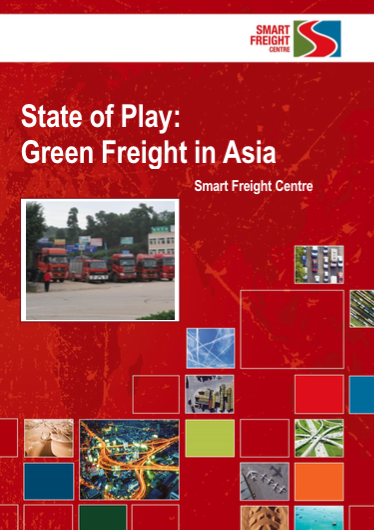Smart freight is within Asia’s reach, according to Smart Freight Centre
 (Smart Freight Center, 18 November 2014) – Asia has ample opportunity to improve the efficiency of its freight and logistics sector and reduce the emissions footprint along the way, according to a study by Smart Freight Centre (SFC), a global organization dedicated to making freight more efficient and environmentally sustainable.
(Smart Freight Center, 18 November 2014) – Asia has ample opportunity to improve the efficiency of its freight and logistics sector and reduce the emissions footprint along the way, according to a study by Smart Freight Centre (SFC), a global organization dedicated to making freight more efficient and environmentally sustainable.
“About 16 trillion dollars’ worth of merchandise is exported every year – and it is growing,” said Sophie Punte, SFC’s Executive Director. “If we want to make a dent in the 6% of global CO2 emissions from freight and logistics, we have to focus on where the biggest growth is, and that is Asia and in particular China and India.”
The report “State of Play: Green Freight in Asia” was released at the Integrated Conference of BAQ 2014 and Intergovernmental 8th Regional EST Forum in Asia, held in Colombo, Sri Lanka. It presents the “state of play” on freight and green freight for Asia’s road sector in support of green freight efforts by industry, government and civil society. Asia is experiencing a vast growth in freight movement due to economic expansion, globalization of markets and urbanization. One of every two trucks worldwide is sold in Asia, and China and India alone will build half of the world’s new roads until 2050.
The downside is that freight is inefficient. Logistics cost as a percentage of GDP ranges from 15-25% in developing Asia — significantly higher than the below 10% observed in the US and Europe. Furthermore, about 90% of trucking companies are individual drivers and up to 40% of trucks on the road are empty. “The trucking sector is extremely fragmented and this is the root cause of inefficiency,” explained Sudhir Gota who conducted the study. “It becomes harder to coordinate freight movement, and combined with a truck overcapacity this puts a downward pressure on prices. To make ends meet, many small operators resort to overloading, for example in India where 70% of heavy-duty trucks on highways are overloaded.”
Trucks, while representing only 9% of Asia’s vehicle population, contribute to 54% of Asia’s CO2 emissions, 90% of China’s PM2.5 emissions and 50% of India’s black carbon emissions from transport, impacting people’s health and exacerbating global warming.
The good news is that there are signs that the situation is changing. Asia’s infrastructure is improving 30% faster than elsewhere in the world. Asian countries are tightening emission standards and introducing fuel economy standards for heavy-duty vehicles. China gives priority to modern and efficient logistics in national strategies and set clear targets: 16% fuel and 20% CO2 reductions per freight ton-km by 2020. Clear winners for trucks are driver training, green tires, light-weight vehicles, telematics and truck scrappage schemes. For example, truck tire technologies could reduce 20 million tons CO2 from China’s 14 million trucks per year.
Green freight programs pull these efforts together and support industry in adopting efficient technologies and solutions across their freight supply chain. Green Freight Asia is an industry-led regional program with a label scheme to reward companies that invest in green freight practices. China, Japan, and Korea now have national programs, and Bangladesh, India and Vietnam are following suit.
“Smart freight is within Asia’s reach” Punte added. “But barriers exist, such as lack of coordination between key players, confidence in technology performance, and access to financing.” In Asia, SFC works with industry and other stakeholders to remove market barriers and drive sector-wide uptake of proven technologies and other measures.
***
The report “State of Play: Green Freight in Asia” is available in here.
Sophie Punte (sophie.punte@smartfreightcentre.org) and Jagir Rathore (jagir.rathore@smartfreightcentre.org)